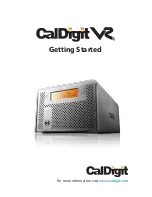
LaCie 4big Quadra Enterprise Class
• D
esign
by
n
eil
P
oulton
RAID
User Manual
page 22
CAUTION:
Following these steps will erase everything from the
4big, including encrypted data. If you have information that you
want to protect or continue to use, back up this information before
performing these steps.
IMPORTANT NOTE:
Formatting will not erase the encryption con-
figuration. If you wish to format a 4big that has been encrypted, you
will first need to unlock the device using the LaCie Desktop Man-
ager, then follow the steps below.
3.4.2. Windows Users
The process of formatting a drive on a computer running Windows
XP or Windows Vista consists of two steps: (1) installing a signature
on the drive, and (2) formatting the drive. These steps will erase
anything that is on the disk.
TECHNICAL NOTE:
Windows XP 32-bit: These operating systems will not recognize vol-
umes greater than 2TB in size.
Windows XP x64, Windows Vista (32- and 64-bit versions), and Win-
dows 7 (32- and 64-bit versions): These operating systems will recog-
nize volumes greater than 2TB in size, but the disks must be converted
to the GPT file system before partitions greater than 2TB can be cre-
ated.
1. Connect the drive to the power source and to the computer via
the interface port.
2. Right-click
My Computer
and select
Manage
.
3. From the “Computer Management” window, select
Disk Man-
agement
(located below the Storage group). See
Fig. 17
(screens may differ slightly depending on the system).
4. If the “Initialize and Convert Disk Wizard” window appears,
click
Cancel
.
5. Windows will list the Hard Disks that are installed on the system.
Locate the drive that is represented by the
icon. Right-click
the icon and select
Initialize
.
6. Windows XP x64, Windows Vista, and Windows 7 users only:
Right-click the disk and click
Convert to GPT
.
7. In the box to the right that says Unallocated, right-click and
select
New Partition…
8. On the first page of the “New Partition Wizard,” click
Next
. See
Fig. 18
(screens may differ slightly depending on the system).
continued on next page...
Fig. 17
Fig. 18










































